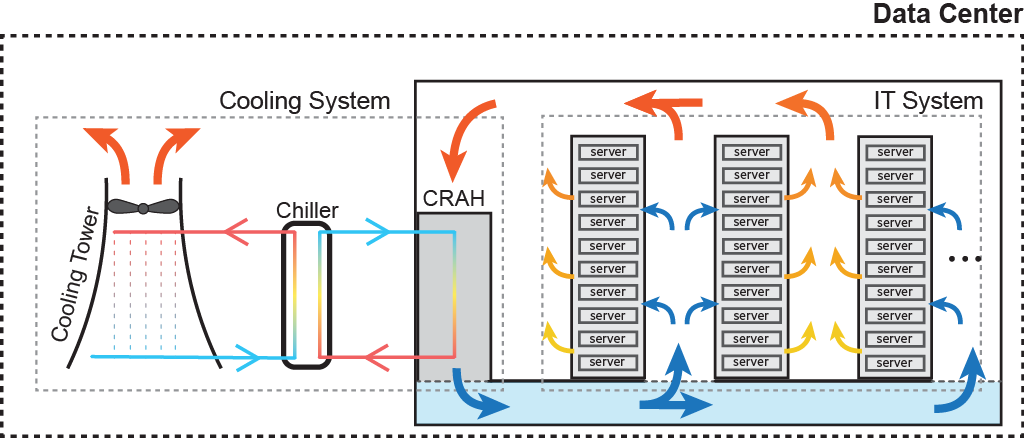Overview¶
Data Center Model¶
High-level overview of the operational model of a SustainDC data center is given in the figure below.

Workloads are uploaded to the DC from a proxy client. A fraction of these jobs can be flexible or delayed to different time periods. The servers that process these jobs generate heat that needs to be removed from the DC. This is done by a complex HVAC system that ensures optimal temperature in the DC. As shown in the figure below, the warm air leaves the servers and is moved to the Computer Room Air Handler (CRAH) by the forced draft of the HVAC fan. Next, the hot air is cooled down to optimal setpoint using a chilled water loop and then send back to the IT room. Parallely, a second water loop transfers the removed heat to a cooling tower, where it is rejected to the outside environment.

Big data centers also incorporate battery banks. Batteries can be charged from the grid during low Carbon Intensity (CI) periods. During higher CI periods, they provide auxiliary energy to the DC.
SustainDC connects core environments and external input data sources to model data center operations.
Core Environments¶
SustainDC consist of three interconnected environments that simulate various aspects of data center operations:
Workload Envronment - model and control the execution and scheduling of delay-tolerant workloads within the DC
Data Center Environment - model and manage the servers in the IT room cabinets that process workloads and the HVAC system and components
Battery Environment - simulates the DC battery charging behavior during off-peak hours and provides auxiliary energy to the DC during peak grid carbon intensity periods
These environments work together to provide a comprehensive platform for benchmarking MARL algorithms aimed at optimizing energy consumption and reducing the carbon footprint of DCs.
SustainDC enables a comprehensive set of customizations for each of the three environments developed in Python. A high-level overview that highlights their individual components, customization capabilities, and associated control problems is given in th figure below.

Input Data Sources¶
SustainDC uses few types of external input data to provide realistic simulation environment:
Workload data - the computational demand placed on the DC
Weather data - the ambient environmental conditions impacting the DC cooling requirements
Carbon Intensity data - the carbon emissions associated with electricity consumption
For more detals on each individual environment, the reinforcement learning algorithms implementeded, the reward functions provided to train the agents, and explanation of external data sources, all needed for succesful SustainDC model, check the links below.